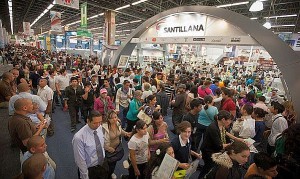2018 School Spending Survey Report
Delivering Quality Spanish-Language Books: The Guadalajara International Book Fair | Consider the Source
How can we bring high quality Spanish-language books into American libraries? The Guadalajara International Book Fair is one answer.

Guadalajara International Book Fair, 2013
How can we bring high quality Spanish-language books into American libraries? Here’s one answer: I recently spent an afternoon with Kay Cassell. a fellow professor at Rutgers, and Linda Goodman of Bilingual Publications. Linda helps connect librarians in the United States with books written in Spanish from around the world. Kay and I were meeting with her to plan a trip to the Guadalajara International Book Fair for our students. Earlier this year, Thom Barthelmess told me that his students at Dominican University would be going to Guadalajara as well, so I thought it was an event worth discussing here. The fair is a conduit to Spanish books that all librarians should know about. This year it runs November 29-December 7, but it’s the first three days that most librarians choose to attend. Linda has been attending the Guadalajara Book Fair since it began in 1987. She explained that the Guadalajara event is different from those in Bologna, Frankfurt, and London. It was created to show the world the best of Mexican publishing, not to sell rights. The focus of the fair has since expanded to include most South and Central American nations; Argentina, for example, is the featured guest country this fall. Guadalajara juggles its identities by having large halls in which publishers display books, another space for rights sales, and then a separate location for literary events. In the evening there are music and cultural activities. To put it another way, at some fairs, where the real action is sales, a librarian can feel like a guest; in Guadalajara the goal is sharing information about authors and books.
Chilean Pavilion at the Guadalajara International Book Fair, 2012
The language of the fair is Spanish. The books, which range from academic and art volumes to literary fiction and picture books, are in Spanish. The events are conducted in Spanish and many conversations are in Spanish. So Guadalajara has the most to offer to a librarian who can at a minimum read the books s/he finds intriguing. But think of the opportunity the fair presents. It is, of course, an occasion to discover many wonderful titles that belong in libraries—books that can serve students whose native language is Spanish and titles for Spanish-language learners. (Linda and other distributors there can arrange to make them available for purchase in the United States). But beyond that the fair can open our eyes to how books for children, tweens, teenagers, and adults can look. Just browsing in Linda's office I saw a volume printed top to bottom; an inviting graphic novel for elementary grade students on Galileo that had more information on his astronomical discoveries than I’ve ever seen in any comparable title; and a publisher whose entire line—including a stunning alphabet book with brilliant black-and-white photos—is entirely devoted to children’s titles featuring cats. Who knows what treasures await in the halls of Guadalajara? I look forward to finding out.RELATED
RECOMMENDED
CAREERS
The job outlook in 2030: Librarians will be in demand
CAREERS
The job outlook in 2030: Librarians will be in demand
ALREADY A SUBSCRIBER? LOG IN
We are currently offering this content for free. Sign up now to activate your personal profile, where you can save articles for future viewing






Add Comment :-
Comment Policy:
Comment should not be empty !!!
Laurie Harrison
I scoured BEA for children's books in Spanish (or bilingual) by Spanish or Latino authors, but didn't get a lot of results. I hope some great published books come from this!Posted : Jul 25, 2014 08:12
Gordon Jack
Thank you for this information. In an effort to bring more high quality Spanish language books into our library (and build greater cross-cultural communication), we are starting an international book club this year called Libros Sin Fronteras with a school in Guadalajara this year. We'll be reading El Tunel by Ernesto Sabato. If there are other schools interested in joining us, check out our website at http://www.librossinfronteras.net. Our kick off event is September 24th!Posted : Jul 23, 2014 07:59